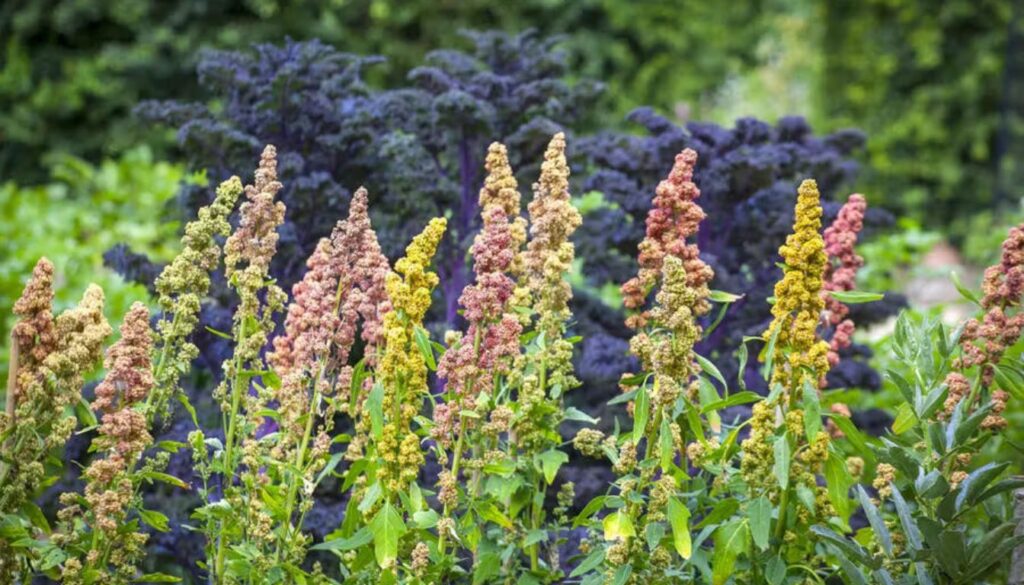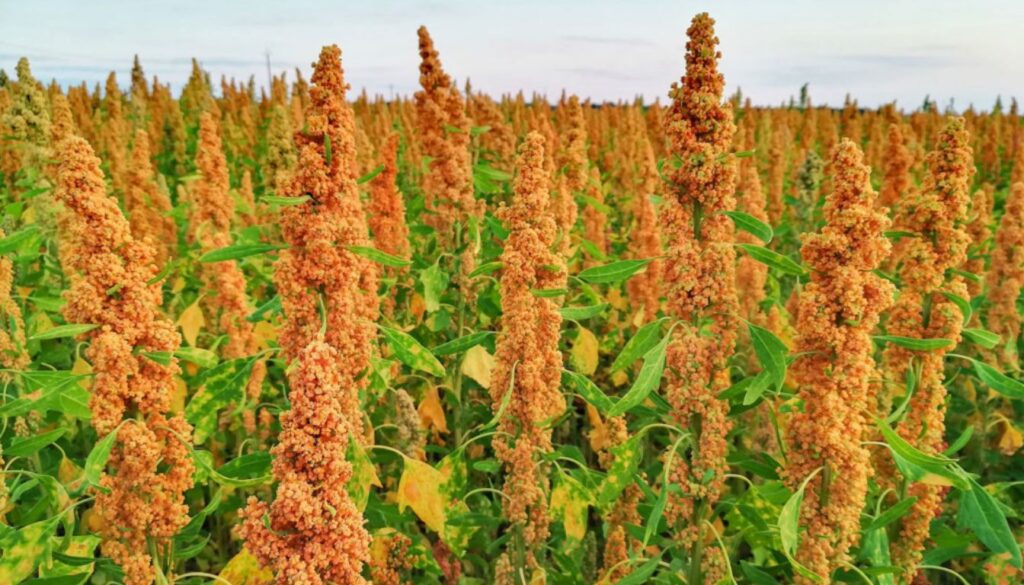If you’ve ever tasted the nutty goodness of quinoa, you know it’s more than just a trendy superfood. It’s a powerhouse packed with protein, fiber, and essential nutrients. But what if I told you that you could grow this nutritious grain right in your backyard? Imagine harvesting your quinoa, enjoying its fresh flavor, and knowing exactly where it came from.
Benefits of Growing Quinoa
Growing quinoa offers several important benefits that make it an appealing choice for backyard gardeners. You gain the opportunity to enjoy fresh, nutritious food while contributing positively to the environment.
Nutritional Value – Guide to Grow Quinoa: A Nutritional Powerhouse at Home
Quinoa packs a punch in nutrition. It contains all nine essential amino acids, making it a complete protein source. Each cup provides about 8 grams of protein and 5 grams of fiber. It’s also rich in vitamins and minerals like magnesium, iron, and B vitamins. Eating quinoa can help with muscle building, digestion, and overall health. Adding it to meals makes dishes more filling and nutritious. Who doesn’t love a food that tastes good and is good for you?
Environmental Impact
Quinoa grows well in various climates, and it requires less water than many traditional crops. This trait makes it an ideal choice for sustainable gardening. Growing quinoa can improve soil health through its deep root system, which prevents erosion and promotes better soil structure.
Additionally, quinoa often doesn’t need synthetic fertilizers or pesticides. I can proudly say that cultivating quinoa not only benefits personal health but also supports environmental sustainability. Plus, it’s a great conversation starter at dinner parties. Who doesn’t want to impress guests with their eco-friendly growing practices?
Ideal Growing Conditions
Growing quinoa successfully depends on specific conditions. Knowing these helps in achieving a fruitful harvest.
Soil Requirements – Guide to Grow Quinoa: A Nutritional Powerhouse at Home
Quinoa thrives in well-drained soil with good fertility. Sandy loam or silty soil offers the best support. A pH level between 6.0 and 7.0 works well. Nutrient-rich soil promotes strong growth and resistance to pests. Adding organic matter improves soil quality. Don’t forget to test your soil before starting. A little preparation goes a long way in ensuring a bountiful harvest.
Planting Process

Planting quinoa involves careful preparation and technique. Getting these steps right ensures a bountiful harvest.
Seed Selection – Guide to Grow Quinoa: A Nutritional Powerhouse at Home
I look for high-quality quinoa seeds for planting. Choosing varieties like ‘Rainbow’ or ‘Black’ adds a splash of color to my garden. Organic seeds often thrive better and promote healthy growth. I check for seeds free of disease to prevent future problems. Buying from reputable suppliers gives peace of mind. The right seeds set the foundation for success.
Sowing Techniques
I prepare my garden for sowing quinoa seeds in spring, when temperatures reach 60°F to 75°F. First, I loosen the soil and ensure good drainage. Then, I create shallow furrows, around 1 inch deep. Spacing seeds 12 to 15 inches apart provides room for growth. I cover seeds gently with soil and water them lightly. I keep the soil moist but not soggy. In about 4 to 7 days, seeds sprout, bringing excitement to my gardening journey.
Maintenance and Care
Caring for quinoa requires attention to detail, but it pays off with a robust harvest. I focus on two main areas: watering practices and pest and disease management.
Watering Practices – Guide to Grow Quinoa: A Nutritional Powerhouse at Home
Quinoa loves moisture, especially during its early growth stages. I usually water the plants deeply once or twice a week. Keeping the soil consistently moist ensures healthy roots. If the weather gets hot, I increase the frequency without drowning the plants. Overwatering can lead to root rot, which is not the goal. In dry spells, I check the soil regularly. A quick finger test works great; if it feels dry an inch down, it’s time to water.
Pest and Disease Management
Pests and diseases are the nemeses of every gardener, but I’ve learned a few tricks. I scout my plants regularly to catch any issues early. Aphids sometimes try to crash the party, but a strong blast of water can send them packing. I also plant marigolds nearby; they repel pests like a boss.
As for diseases, good airflow prevents mold and mildew. I space my quinoa plants well to promote this. If I spot any sick plants, I remove them right away to protect the others. Keeping tabs on these areas helps my quinoa flourish and keeps my garden fun.
Harvesting and Processing
Harvesting quinoa requires careful timing and attention. Quinoa seeds turn a beautiful shade of golden brown when they’re ripe. Harvesting typically occurs six to eight weeks after flowering, usually in late summer or early fall.
Timing for Harvest – Guide to Grow Quinoa: A Nutritional Powerhouse at Home
Knowing when to harvest can make a big difference. I watch for signs that indicate ripeness. When the leaves start drying out and seeds feel firm, it’s time to act. I ensure that at least 90% of the seeds have changed color. Late afternoon works best for harvesting, as plants are drier then, preventing excess moisture during processing.
Methods of Processing
Processing quinoa involves a few key steps. First, I remove the seeds from the plant. I shake the seed heads into clean containers or use a pair of scissors to snip them off. Next comes cleaning. Quinoa has a natural coating called saponin, which can taste bitter. Rinsing seeds under cold water eliminates the saponin, enhancing flavor. I often shake them gently in a colander to make this easier.
Drying seeds is essential too. I spread them out on a clean surface and let them dry thoroughly. This ensures good storage later. Finally, storing clean, dry quinoa in an airtight container keeps it fresh for months.
Growing and processing quinoa can be quite the adventure. It’s rewarding to see the whole journey from seed to table.
Before You Go – Guide to Grow Quinoa: A Nutritional Powerhouse at Home

Growing quinoa in my backyard has been a rewarding experience that combines health benefits with environmental sustainability. I’ve enjoyed the satisfaction of nurturing my plants and harvesting fresh seeds, knowing exactly where my food comes from.
The process may seem daunting at first, but with the right techniques and care, anyone can successfully grow quinoa. It’s not just about the nutritious grain; it’s about connecting with nature and embracing a sustainable lifestyle.
Whether you’re a seasoned gardener or just starting out, I encourage you to give quinoa a try. You’ll not only enhance your diet but also contribute positively to the planet. Happy gardening!
Don’t forget to add theherbprof.com homepage to your favourites so you don’t miss out on future articles.
References – Guide to Grow Quinoa: A Nutritional Powerhouse at Home
Little Herb Encyclopedia, by Jack Ritchason; N.D., Woodland Publishing Incorporated, 1995
The Ultimate Healing System, Course Manual, Copyright 1985, Don Lepore
Planetary Herbology, Michael Tierra, C.A., N.D., Lotus Press, 1988
Handbook of Medicinal Herbs, by James A. Duke, Pub. CRP Second Edition 2007
The Complete Medicinal Herbal, by Penelope Ody, Published by Dorling Kindersley
Check the Following Article
Eating Fruits in the Morning: Benefits and Breakfast Tips
Guar Bean: Amazing Health Benefits for Your Diet
Fish Oil for PCOS: Benefits and Symptom Management
Easy Tips to Grow Zinnias Indoors: Vibrant Blooms at Home
Frequently Asked Questions – Guide to Grow Quinoa: A Nutritional Powerhouse at Home
What is quinoa, and why is it considered a superfood?
Quinoa is a nutritious seed known for its high protein content, fiber, and essential nutrients. It’s categorized as a superfood because it contains all nine essential amino acids, significant vitamins, and minerals, supporting muscle building, digestion, and overall health.
Can I grow quinoa in my backyard?
Yes, you can grow quinoa in your backyard! It’s a sustainable gardening choice that allows you to enjoy fresh, nutritious food while having control over its source. Quinoa is adaptable to various climates and has lower water requirements.
What are the ideal growing conditions for quinoa?
Quinoa thrives in well-drained, nutrient-rich soil with a pH level between 6.0 and 7.0. Sandy loam or silty soil is recommended, and improving soil quality with organic matter can enhance growth. Testing the soil before planting is also advised.
What seeds should I use to grow quinoa?
For optimal results, select high-quality quinoa seeds, such as ‘Rainbow’ or ‘Black’ varieties. Ensure that the seeds are disease-free to promote healthy growth and a successful harvest.
When is the best time to plant quinoa?
The best time to plant quinoa is in the spring when temperatures are between 60°F to 75°F. Preparing the soil and creating shallow furrows for sowing will help ensure successful germination.
How should I care for quinoa plants?
Quinoa requires consistent moisture, especially in the early growth stages. Water deeply once or twice a week, manage pests with water blasts or companion planting, and ensure good airflow to prevent diseases.
When and how should I harvest quinoa?
Quinoa seeds should be harvested when they turn golden brown, typically six to eight weeks after flowering. Look for drying leaves and firm seeds, harvest in the late afternoon, and follow processing steps to remove the bitter saponin coating.
How do I store harvested quinoa?
After harvesting and rinsing quinoa seeds to remove saponins, dry them thoroughly and store them in airtight containers. This helps maintain freshness and ensures your homegrown quinoa remains nutritious.

